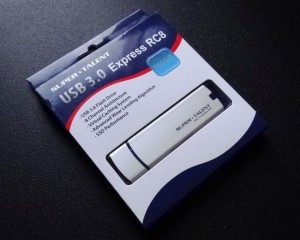 It was just over a year ago that we reviewed the Super Talent 50GB RC8 ‘SandForce Driven’ USB 3 Flash Drive and made the call of it being the fastest flash drive on the planet.
It was just over a year ago that we reviewed the Super Talent 50GB RC8 ‘SandForce Driven’ USB 3 Flash Drive and made the call of it being the fastest flash drive on the planet.
Our prediction then was that it would be a natural progression that, soon enough, we would be booting complete systems off of just this type of media. Imagine, simply plugging your flash drive in and accessing your desktop environment anywhere.
 Our analysis today looks at the Super Talent USB3 Express RC8 100GB Flash Drive and, not only does it easily command bragging rights as the most powerful large capacity Flash Drive on the planet but also, the RC8 is one of the very few certified for the Microsoft Enterprise ‘Windows To Go’ Operating Environment.
Our analysis today looks at the Super Talent USB3 Express RC8 100GB Flash Drive and, not only does it easily command bragging rights as the most powerful large capacity Flash Drive on the planet but also, the RC8 is one of the very few certified for the Microsoft Enterprise ‘Windows To Go’ Operating Environment.
As luck may have it in fact, I am typing this report within Windows To Go as we speak, Super Talent having been nice enough to include the 90 day evaluation package with the RC8.
Stay tuned as we even go one better and start a two week worldwide draw for one of these 100GB ‘LSI SandForce Driven’ Windows To Go enabled Flash Drives on posting of this report. Now this is going to be sweet; a 100GB USB 3 Flash Drive that hits 270MB/s and will start it’s own environment on ANY Windows 7 or 8 computer in the world.
RC8 SPECIFICATIONS
The Super Talent USB3.0 Express RC8 Flash Drive is available in capacities of 25, 50 and 100GB and can be found right now at prices of $99.99![]() , $232.48
, $232.48![]() , and $340.99
, and $340.99![]() . Performance specifications are listed at 270MB/s read and 240MB/s write, the exterior is of an attractive aluminum shell and the RC8 comes with a standard 5 year warranty. Obviously, in considering performance, components, warranty and price, this is a niche product that will be of definite appeal for a specific workset.
. Performance specifications are listed at 270MB/s read and 240MB/s write, the exterior is of an attractive aluminum shell and the RC8 comes with a standard 5 year warranty. Obviously, in considering performance, components, warranty and price, this is a niche product that will be of definite appeal for a specific workset.
RC8 COMPONENTS
The Super Talent USB3.0 Express RC8 flash drive is ‘LSI SandForce Driven’ and every bit as much of a SSD as one might imagine. It contains the SF-1222 Flash Storage Processor, four modules of Micron 25nm asynchronous 32GB NAND flash memory, as well as an ASMedia ASM-1051 USB to SATA bridge which routes data from the SF-1222 SATA 2 FSP through the RC8s USB3.0 interface.
 The four modules of NAND flash memory provide a total of 128GB of raw storage capacity, however, over provisioning reduces that slightly in order to provide for continued performance and endurance. Formatting also reduces the user capacity slightly, however surprisingly, there is 107GB available to the user which goes against the grain of typical advertised capacities where final formatting is usually less than the advertised capacity. In this case, we are an extra 7GB to the positive.
The four modules of NAND flash memory provide a total of 128GB of raw storage capacity, however, over provisioning reduces that slightly in order to provide for continued performance and endurance. Formatting also reduces the user capacity slightly, however surprisingly, there is 107GB available to the user which goes against the grain of typical advertised capacities where final formatting is usually less than the advertised capacity. In this case, we are an extra 7GB to the positive.
For those a bit more interested in the memory specifications, the FBGA code of NW292 matches part number MT29F256G08CMAAAC5.
 The SSD Review The Worlds Dedicated SSD Education and Review Resource |
The SSD Review The Worlds Dedicated SSD Education and Review Resource | 
Can I use this to test my HDD?
No, there is a disconnect between that of the USN WTG environment and the PC itself.
Thanks
Now I really need this.
Hi
Is it me or the Crystal DiskMark compressible results are not right, since the program appears not have finished? (the 4 boxes on the left say ‘Stop’ which means the program is still running)
Ya I grabbed the shot just a bit early but the scores are same…
Great review. This is like reading a very good book. Thanks.
Great review. But I think it would be better if you would compare it with spyrus and kingston workspace and hyperx
Great review, thanks!
Dependability is extremely low. I have rma’d 3 50GB RC8 since sept and have one on the desk right now that ran for a total of 4 days. Dang shame as this is one of the most amazing and fastest thumb drives ever made. SuperTalent support leaves a lot to be desired.
Ron Burnes
how much does it cossst